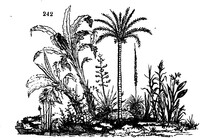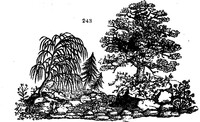1023. The distinctions of the two great classes of phï¾µnogamous, or flowering, plants, it thus appears, are obvious at a glance; and so far is it from there being any necessity for dissecting a seed in order to ascertain its structure, that this point is one of the most easy determination, and about which there cannot be in one case in five hundred the slightest cause of doubt or difficulty. It is almost impossible to see even a morsel of a plant without instantly being in possession of the knowledge of the structure of its seed, with respect to the cotyledons. Even in a general view the difference is conspicuous, as may be seen by comparing the monocotyledonous group (fig. 242.) with the dicotyledonous group (fig. 243.). It would take too much space in a work like the present to explain the characters of all the orders, and the manner of determining them; but what has been already stated will suffice to show that there is no great difficulty to be encountered to gain a knowledge of the natural system; and it is well worth the trouble of acquiring it, as the system of De Candolle has now, Dr. Lindley observes, 'almost superseded all others, partly because of its easiness and simplicity, and most especially because it is that which has been followed in the Author's Prodronius, or celebrated description of species.' (Lindley's Vegetable Kingdom, p. xxxv.)



